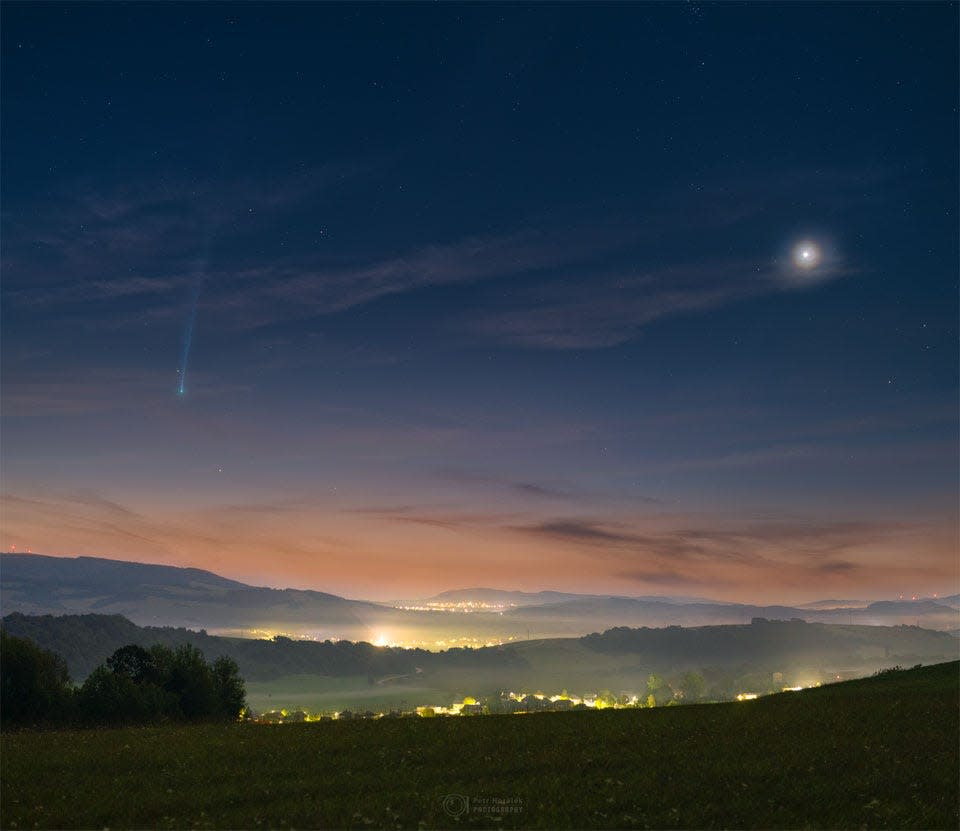A 'Devil Comet' twice the size of Everest will pass over Earth. Here's how to see it
A comet known as the "Devil Comet," twice the size of Mount Everest, is currently approaching Earth.
This comet, scientifically labeled as 12P/Pons-Brooks, is a periodic comet with an orbital period of approximately 71 years and is one of only about 20 comets known to have an active ice volcano. The comet will reach its peak brightness for skywatchers next year when it will be about 144 million miles away from Earth.
There's a chance the Devil Comet might be visible to the naked eye, and it almost certainly will be visible with binoculars or a small telescope. However, comets are notoriously unpredictable in terms of their brightness, making it a wait-and-see situation for skywatchers.
The Devil Comet earned its nickname from its distinctive "horns," which are actually tails of gas and dust resulting from unusual outbursts that scientists are still studying.
Here is everything you should know about the Devil Comet.
The Taurid meteor streams to peak: Here's what they are and how to see them
What is the Devil Comet?
The celestial object nicknamed the Devil Comet is formally called Comet 12P/Pons-Brooks. It is a Halley-type comet, meaning it has a long orbit, in this case about 71 years on its way toward the sun.

"The reason it's been in the news and attracted so much attention is that it has had several major outbursts, or sudden and rapid increases in how bright it is," said Theodore Kareta, a postdoctoral researcher at Lowell Observatory in Flagstaff.
"This is driven by a large amount of dust and gas being thrown off the comet at the same time. The material expanding away from the comet can show structures that can be rather evocative."
The name "Devil Comet" caught on because the expanding material looks like two little horns. Kareta said similar kinds of outbursts from other comets have been described as "Pac-Man Shaped" for similar reasons.
What is a cryovolcanic comet?
A cryovolcanic comet, also known as an icy volcano or cryovolcano, exhibits volcanic activity involving the eruption of volatile substances like water, ammonia, methane or carbon dioxide, rather than molten rock and magma as seen in traditional volcanoes on Earth.
Cryovolcanic eruptions release gases, water and icy materials into space, which quickly freeze in the cold environment, creating distinctive surface features, according to Earth.com.
Will Comet 12P hit Earth?
Comet 12P/Pons-Brooks is not considered a threat to Earth. It is a periodic comet with a well-determined orbit, and its path does not intersect with Earth's orbit in a way that would lead to a collision.
"There is nothing to worry about. This poses no danger to humans, and the comet will not get close to the Earth at all," Kareta said.
"Having a comet have so many significant outbursts in such a short period of time is rare, though, and this is part of why it's become such an interesting object for scientists who study comets. In other words, it's photogenic and interesting, not dangerous."
It is estimated that the comet will pass Earth in April 2024. People will be able to see it in May and June, with its peak brilliance predicted for June 2, 2024.
"Comet Pons-Brooks will be reaching maximum brightness at the end of next spring between April and June, and current predictions put it bright enough to be seen with your naked eyes from a dark sky site far from the big cities. Even if it isn't quite as bright as expected, seeing it with binoculars or a small backyard telescope should be relatively easy," Kareta said.
After June 2024, the comet will not be seen again until 2095, according to Earth.com.
Where is the comet 12P?
The location of a comet-like 12P/Pons-Brooks varies as it orbits the Sun.
According to theskylive.com, “Comet 12P/Pons-Brooks is currently in the constellation of Hercules. The current right ascension of Comet 12P/Pons-Brooks is 17h 40m 43s and the declination is +42° 00’ 09”.”
How big is the 12P comet?
As noted on Earth.com, “Such comets are intriguing; they have a solid core that spans an impressive 18.6 miles (30 km) and consists of a mix of ice, dust and gases.”
This comet is considerably larger than most other fireballs and is roughly twice the size of Mount Everest.
See the most beautiful meteors over AZ: The Orionids are coming.
"We think that when comets formed some 4.5 billion years ago, they formed with a wide range of sizes. Most are small, but a small fraction can be significantly larger," Kareta said.
"What scientists don't know is how larger comets might be different than smaller comets. Do they have the same structure on the inside? Do they behave the same way? Those kind of questions are what we're keen to investigate when we study objects like Pons-Brooks."
Got a story you want to share? Reach out at Tiffany.Acosta@gannett.com. Follow @tiffsario on Instagram.
Support local journalism and subscribe to azcentral.com.
This article originally appeared on Arizona Republic: 'Devil Comet' is approaching Earth. Here's the date you can see it

